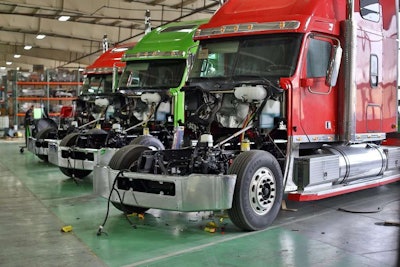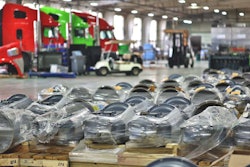 Thousands of comments were filed during the 60-day window for the Environmental Protection Agency’s proposal to roll back a portion of Phase 2 emissions standards that applied to glider kits.
Thousands of comments were filed during the 60-day window for the Environmental Protection Agency’s proposal to roll back a portion of Phase 2 emissions standards that applied to glider kits.Thousands of public comments were filed in the recent 60-day window offered by the Environmental Protection Agency on its proposal to unwind emissions regulations placed on glider kit trucks by the sweeping Phase 2 emissions standards enacted in the final year of President Obama’s administration. And according to those public comments, there is no general industry consensus on the issue. Owner-operators mostly sounded off in favor of EPA’s move to rescind the regulations, while representatives from fleets, truck OEMs, dealers and environmental groups filed comments asking the EPA to maintain the fresh restrictions placed on glider kits.
If the proposal to remove glider kits from the Phase 2 regulations fails, glider vehicle makers would only be allowed to build up to 300 trucks a year that do not comply with Phase 2 standards. Companies like Fitzgerald Glider Kits have been making thousands of gliders each year, so under current Phase 2 rules, would be forced to alter their operations to comply.
Here’s a sampling of comments filed on the proposal, including those from prominent trucking trade groups American Trucking Associations and Owner-Operator Independent Drivers Association.
OOIDA says removing glider kits from Phase 2 of the regulations “provides truckers with affordable and reliable vehicle choices when they are purchasing either new or used trucks.” The group states glider kits are often favored by small business truckers because of their “affordability and reliability,” adding that glider kits are typically 25-30 percent cheaper than new trucks.

A single truck owner-operator commenting as Kristopher says he currently drives an older truck because the work he does in oil fields “has proven to be too tough on trucks that have emissions controls.” He says he has seen a number of new trucks break down in his line of work, with repair costs putting some operators out of business. He adds that he hopes to buy a glider kit in the future because of how well the hold up in the tough conditions. “I will be forced to just keep fixing mine and running it,” he says.
A number of owner-operators who commented anonymously had similar thoughts. One anonymous commenter says he owns two trucks – a 1991 and a 1999 – and if he had to replace either, “it would be a glider kit instead of a new truck. He adds they are “cheaper and easier to maintain, more reliable and have better fuel efficiency than new emission trucks.”
Another small trucking company owner says he will be looking to install the drivetrain from his older truck into a glider kit as the body and interior of his truck wear out. “Purchasing a glider or keeping the old trucks “as is” would be my only choices as the new trucks with all the new technology are too expensive to purchase and way too expensive to maintain,” he says.
One commenter in favor of the repeal says glider kits are “very vital moving forward for independents.” Like others, he cites reliability, fuel economy and costs as reasons gliders are so popular among owner-operators. “This glider I own is less expensive to build, gets better fuel economy, has a proven history of unprecedented [sic] reliability” and adds to his profitability.
Another driver who says he bought a glider in 2016 says “small business truckers cannot play the new truck lottery,” adding that emissions-related issues seen in some new trucks would bankrupt many owner-operators.
While glider kit manufacturers and some dealers are in favor of rolling back the emissions regs on gliders, many truck dealers want to keep the current rules in place.
Tennessee-based Fitzgerald Glider Kits also weighed in on the EPA’s proposal, stating many of its customers cannot afford new trucks from OEMs, but still want the latest safety features, amenities and styles. The company contends that glider kits are not new vehicles because they contain previously-owned engines, transmissions and rear axles. Because the powertrains of gliders were previously owned, they cannot be classified as new, Fitzgerald adds. Echoing comments from owner-operators, the company says its gliders “cost less to maintain and repair, get better gas mileage in most circumstances, and experience fewer breakdowns.” Additionally, Fitzgerald says that because the engines used in gliders are pulled out of older trucks and rebuilt before going into a glider, it improves emissions impacts by taking an older truck off the road.
The Glider Kit Association of America echoes Fitzgerald’s comments, stating glider manufacturers and their customers “have never considered gliders as new motor vehicles.” GKAA adds that states don’t title gliders as new vehicles, either.
Iowa-based Harrison Truck Centers, a new and used Freightliner and Western Star dealer, is also in favor of rolling back the regulations on glider kits. Harrison also builds and sells Freightliner and Western Star gliders. The company says gliders “provide an affordable stepping stone to the eventual purchase of a new OEM truck.”
An anonymous OEM dealer that currently also builds glider kits commented in opposition of repealing the glider kit regs. The commenter states they “do not believe that continuing the practice of building trucks that exceed current emissions levels by 25 times or more makes any sense from an environmental standpoint.”
TriState Truck Center, a Volvo and Mack truck dealer headquartered in Memphis, Tenn., says “glider kits create an unfair advantage” because the prices of new trucks have risen in recent years to comply with emissions standards. “Because of a loop hole in the law, certain companies have started selling glider kits with engines that are not EPA compliant and have a tremendous price advantage against us,” company President Jim Maddox states in his comments. Additionally, Maddox states that new truck dealers have to collect a 12 percent federal excise tax from buyers, and “there is no clear understanding on whom, if anyone, collects this tax on the glider kits.”
The Truck Renting and Leasing Association, whose members purchase between 25 and 30 percent of all new trucks annually, states gliders should be classified and regulated as new trucks. The group states that because gliders are not considered new trucks and buyers don’t have to pay the 12 percent federal excise tax, the nation’s infrastructure suffers due to a decline in tax money entering the Highway Trust Fund. “Encouraging fleets to replace older vehicles with less regulated gliders is contrary to congressional intent under the Clean Air Act,” the group says.
Fleets and OEMs themselves have also weighed in on the issue in opposition to the proposed repeal.
The Truck and Engine Manufacturers Association (EMA) states that removing gliders from the Phase 2 regulations would create uncertainty with the regulations. The group says that EPA’s reinterpretation of what constitutes a “new vehicle” makes it so a new vehicle can be comprised entirely of new parts, meaning any vehicle with a powertrain made up of any used parts would fall outside the regulations. “The net result would be that an engine and vehicle manufacturer could avoid all regulation of the sale of its new engines and vehicles so long as the engines used in the final assembly of otherwise brand new vehicles included at least some refurbished parts,” EMA adds.
Daimler Trucks North America echoes EMA’s comments and adds glider kits “should not be used for circumventing purchase of currently certified powertrains.” DTNA says it supports the Phase 2 rules as originally written.
Finally, the American Trucking Associations weighed in on the opposition of repealing the standards, stating EPA has the authority to regulate rebuilt engines under the Clean Air Act and should do so. ATA adds that the growth of gliders creates a “competitive disadvantage for fleets purchasing new equipment.” The group says its members buy a lot of new equipment “and pay a premium price investing in clean engine technologies.”











